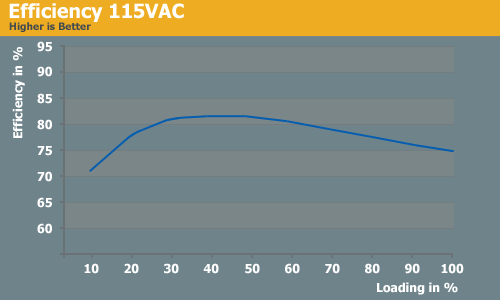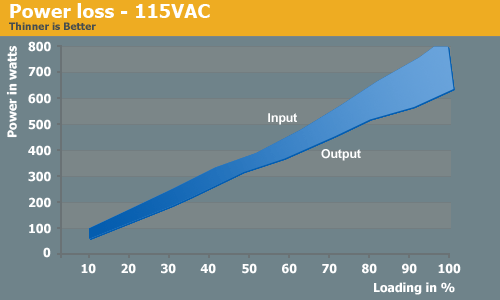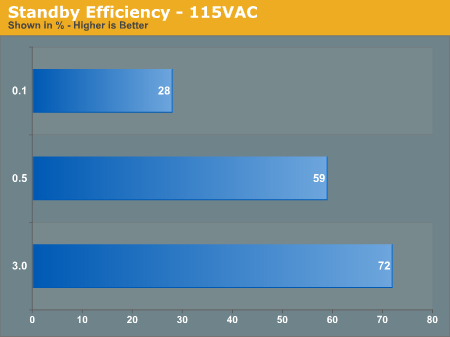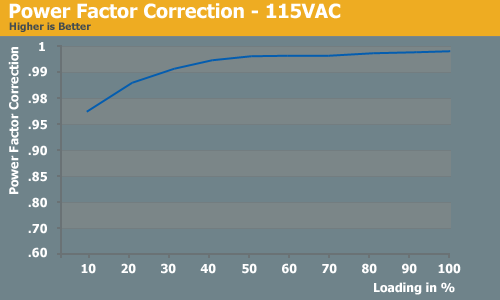The Single 12V Rail SilverStone Olympia OP650
by Christoph Katzer on July 13, 2007 12:00 PM EST- Posted in
- Cases/Cooling/PSUs
115VAC Efficiency, Power loss and PFC
Efficiency is one of the most important factors nowadays in power supplies. PSU marketing and advertising are completely dependent on efficiency in most cases. At 115VAC we have measured a little more than 80% efficiency from 25% to 60% load. That is surely an impressive number with 115VAC. It is nice to see that Silverstone is able to maintain this high efficiency through the full spectrum of loads and not only for a few specific loads like some other power supplies. After it reached its zenith it steadily declines in efficiency, but not too rapidly.

Due to a high efficiency the power loss was in quite good shape as well. The thinner this graph is the less power loss we have measured. The loss of power is always higher towards the highest load which results in the figure below.

Even when you turn your PC off it is, unfortunately, still using energy if you don't hit the hard power switch on the backside. This is the standby function which lets the PC start with soft power features like wake on LAN. Since the PC is on standby it is always using energy from the grid. We have included this test to check power supply's standby function and their energy usage while the PC is off. With 115VAC the OP650 is using 1.19 watts of energy while doing "nothing" which is not a very high result. If you leave the PC off for a long period of time, you should still always hit the switch or unplug the cable.
To test the standby-efficiency we are using the loads of 0.1, 0.5 and 3.0 Ampere on the 5VSB rail while the power supply is not running. The result is the efficiency of each load shown below. The results are quite average but not low. A standby-efficiency of 72% with 3 Ampere of load is very good.

Power factor correction works fine and delivers the usual high results. It always performs better at 115VAC as opposed to 230VAC.

Efficiency is one of the most important factors nowadays in power supplies. PSU marketing and advertising are completely dependent on efficiency in most cases. At 115VAC we have measured a little more than 80% efficiency from 25% to 60% load. That is surely an impressive number with 115VAC. It is nice to see that Silverstone is able to maintain this high efficiency through the full spectrum of loads and not only for a few specific loads like some other power supplies. After it reached its zenith it steadily declines in efficiency, but not too rapidly.

Due to a high efficiency the power loss was in quite good shape as well. The thinner this graph is the less power loss we have measured. The loss of power is always higher towards the highest load which results in the figure below.

Even when you turn your PC off it is, unfortunately, still using energy if you don't hit the hard power switch on the backside. This is the standby function which lets the PC start with soft power features like wake on LAN. Since the PC is on standby it is always using energy from the grid. We have included this test to check power supply's standby function and their energy usage while the PC is off. With 115VAC the OP650 is using 1.19 watts of energy while doing "nothing" which is not a very high result. If you leave the PC off for a long period of time, you should still always hit the switch or unplug the cable.
To test the standby-efficiency we are using the loads of 0.1, 0.5 and 3.0 Ampere on the 5VSB rail while the power supply is not running. The result is the efficiency of each load shown below. The results are quite average but not low. A standby-efficiency of 72% with 3 Ampere of load is very good.

Power factor correction works fine and delivers the usual high results. It always performs better at 115VAC as opposed to 230VAC.











46 Comments
View All Comments
Araemo - Friday, July 13, 2007 - link
That makes sense, and makes me think my guess about the 20A limit is possibly a contributing factor - It would be a safety issue if someone hung 40A worth of fans, lights, motorized case windows, whatever you want.. off of one pair of wires (IE, one molex connector feeding into the mass of extenders and passthrough connectors that most fans and lights I've seen use.).You'd likely overheat the wires carrying all that power, if not the connectors as well, which could cause fire or electrocution hazards.
While a GPU may draw significantly more than 20A, they are also using 3 pairs now, so the actual power draw will be closer to 20A per pair.
DerekWilson - Friday, July 13, 2007 - link
The PCIe V2.0 PSUs I've seen suggest only using connectors from the same 12V rail for PCIe graphics cards -- because if you don't, you'll be connecting the common from two different 12V rails together.This can cause issues.
If a graphics card has one 4pin and 1 8pin connector, like the HD 2900 XT, the GPU can potentially draw up to 225W from a single 12V rail through 2x PCIe graphics power connectors (3 pairs). That's about 19 amps through one rail for one PSU, but not over each pair.
SilthDraeth - Friday, July 13, 2007 - link
They explained it.The Intel ATX standard calls for no more than 20 Amps per 12V rail. So in order to avoid maxing out a single 12V rail at 20 Amps, PSUs have multiple rails support up to 20 Amps each.
If you use a single rail that can max out at 54 Amps as stated here, then you do not need the additional rails, but you are going against the ATX standard.
Duraz0rz - Friday, July 13, 2007 - link
Also, I didn't see if there was a reason that it was advertised as a single rail, yet you have 4 12V rails.Nice article...really love the line curves for the load outputs. One thing I noticed missing is ripple testing. Any reason why it's not here?
SilthDraeth - Friday, July 13, 2007 - link
That confused me as well. I think they mentioned that the PSU supposedly includes an ability to turn the other rails off, but it doesn't work, and it always has 4. They did state the PCB was originally designed for 4 rails.Duraz0rz - Friday, July 13, 2007 - link
Nevermind...disregard my statement about the ripple testing. I probably just missed it in the original article after skimming the comments from it :)